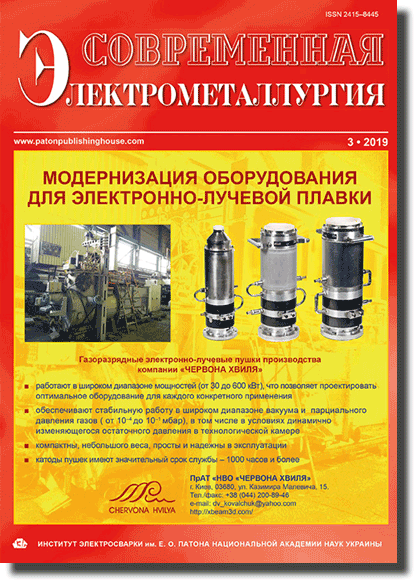| 2019 №03 (02) |
DOI of Article 10.15407/sem2019.03.03 |
2019 №03 (04) |

Electrometallurgy Today (Sovremennaya Elektrometallurgiya), 2019, #3, 15-22 pages
Journal Современная электрометаллургия
Publisher International Association «Welding»
ISSN 2415-8445 (print)
Issue № 3, 2019 (September)
Pages 15-22
Laboratory electron beam unit UE-208M
S.V. Akhonin1, A.N. Pikulin1, V.A. Berezos1, D.V. Kovalchuk2, S.B. Tugai2
1E.O. Paton Electric Welding Institute of the NAS of Ukraine. 11 Kazimir Malevich Str., Kyiv, 03150, Ukraine. E-mail: office@paton.kiev.ua
2PSJC «NVO «Chervona Khvilyia». 15 Kazimir Malevich str., Kyiv, 03680, Е-mail: master@chervonahvilya.com
Laboratory electron beam unit UE-208M was developed, which is fitted with gas-discharge electron guns VTR-300 designed by PJSC «NVO «Chervona Khvilya». In order to produce a block of electron beam heaters UE-208M appropriate technical documentation was developed, components and assemblies of electron beam heater plate, ensuring mechanization and automation of its movement, as well as automated self-contained system of cooling of the electron beam heaters, were manufacture and mounted. Work has been performed on producing ingots of a nickel-based alloy of Ni–Al–Cr system with increased content of alloying elements with a high pressure of Al and Cr vapours. It is found that melting in the developed laboratory electron beam unit UE-208M was performed in a stationary mode, and no significant deviations provoked by intensive vapour flow from the liquid metal mirror at operation of gas-discharge electron guns were found. It is shown that application of gas-discharge electron guns VTR-300 of PJSC «Chervona Khvilya» design as a concentrated energy source, allows performing work on development and optimization of new electron beam technologies of melting refractory and highly-reactive metals, as well as alloys with a high content of volatile alloying elements, while ensuring the high operational reliability. Ref. 10, Tabl. 2, Fig. 8.
Key words: electron beam melting; electron beam unit; electron gun; technological fixture; ingot; alloy; alloying elements; impurities
Received: 11.03.19
Published: 03.10.19
References
1. Azhazha, V.M., Vyugov, P.N., Lavrinenko, S.D. et al. (1998) Zirconium and its alloys: Technology of production, fields of application. Kharkov, NSC KhFTI [in Russian].2. Paton, B.E., Trigub, N.P., Akhonin, S.V., Zhuk, G.V. (2006) Electron beam melting of titanium. Kiev, Naukova Dumka [in Russian].
3. Tikhinsky, G.F., Kovtun, G.P., Azhazha, V.M. (1986) Production of ultrapure rare metals. Moscow, Metallurgiya [in Russian].
4. Paton, B.E., Trigub, N.P., Akhonin, S.V. (2008) Electron beam melting of refractory and high reactive metals. Kiev, Naukova Dumka [in Russian].
5. Azhazha, V.M., Vyugov, P.N., Lavrinenko, S.D. et al. (2002) Electron beam melting of titanium, zirconium and hafnium. Voprosy Atomnoj Nauki i Tekhniki, 6, 95–99.
6. Dmitrenko, A.E., Pelykh, V.N., Pilipenko, N.N. (2004) Refining of hafnium by method of electron beam melting. Ibid., 3, 112–115 [in Russian].
7. Trigub, N.P., Akhonin, S.V., Zhuk, G.V. et al. (2006) Electron beam melting of uncrushed spongy titanium blocks. Advances in Electrometallurgy, 4, 6–9.
8. Tikhonovsky, A.L., Lashuk, N.K., Tur, A.A. et al. (1993) Electron beam melting of spongy titanium using guns of high-voltage glow discharge. Problemy Spets. Elektrometallurgii, 10, 66–70 [in Russian].
The cost of subscription/purchase order journals or individual articles
| Journal/Currency | Annual Set | 1 issue printed |
1 issue |
one article |
| TPWJ/USD | 384 $ | 32 $ | 26 $ | 13 $ |
| TPWJ/EUR | 348 € | 29 € | 24 € | 12 € |
| TPWJ/UAH | 7200 UAH | 600 UAH | 600 UAH | 280 UAH |
| AS/UAH | 1800 UAH | 300 UAH | 300 UAH | 150 UAH |
| AS/USD | 192 $ | 32 $ | 26 $ | 13 $ |
| AS/EUR | 180 € | 30 € | 25 € | 12 € |
| SEM/UAH | 1200 UAH | 300 UAH | 300 UAH | 150 UAH |
| SEM/USD | 128 $ | 32 $ | 26 $ | 13 $ |
| SEM/EUR | 120 € | 30 € | 25 € | 12 € |
| TDNK/UAH | 1200 UAH | 300 UAH | 300 UAH | 150 UAH |
| TDNK/USD | 128 $ | 32 $ | 26 $ | 13 $ |
| TDNK/EUR | 120 € | 30 € | 25 € | 15 € |
AS = «Automatic Welding» - 6 issues per year;
TPWJ = «PATON WELDING JOURNAL» - 12 issues per year;
SEM = «Electrometallurgy Today» - 4 issues per year;
TDNK = «Technical Diagnostics and Non-Destructive Testing» - 4 issues per year.





